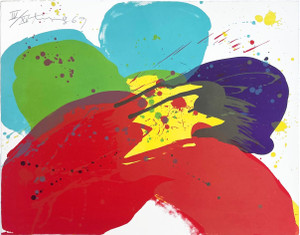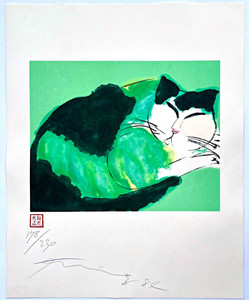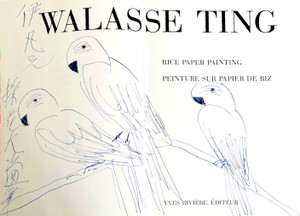
Walasse Ting 丁雄泉, Chinese Moonlight (signed, dated and inscribed by Walasse Ting), 1967
Walasse TingCONTACT GALLERY FOR PRICE
Walasse Ting 丁雄泉
Chinese Moonlight (signed, dated and inscribed by Walasse Ting), 1967
Illustrated Softback monograph with four original double-page lithographs (hand signed, dated and inscribed)
Signed and inscribed by Walasse Ting on the half title page
10 1/2 × 7 1/2 × 1/2 inches
Inscription reads:
to Frances Klenett
with very best wishes
from
Walasse Ting
new york city 15 December 1972
(Frances Klenett was a composer, teacher and rare-book dealer. She was married to Eric Salzman, Avant Garde composer and music critic)
Book information:
CHINESE MOONLIGHT: 63 poems by 33 poets
Publisher: Wittenborn and Co; (January 1, 1967)
English; softback with 71 pp of Chinese poetry (63 works) by 33 poets, selected, translated and illustrated by 4 double-page lithographs by Ting.
About Walasse Ting:
Born in Wuxi, China, then raised in Shanghai, where, by his own account he first began painting on the sidewalks.
Without a visa and only five American dollars in his pocket he moved to Paris in 1952. Life was difficult but he found a small room in Passage Riguinot.
Having met Pierre Alechinsky, who he taught oriental calligraphy to, he was introduced and formed close friendships with members of the CoBrA Group, the avant-gard movement. Eight years later Ting emigrated to New York, where he became involved with the Pop artists and influenced by American Abstract Expressionism.
The conflict of conservative Eastern values and the modern Western culture is apparent in Ting’s work, he states “in this respect, artists are to a certain extent schizophrenics. Some try to resolve the contradiction by conscious means, by using traditional techniques and elements of traditional Chinese art in an attempt to modernize Chinese painting”.
Julian Alvard noted in 1954 “the influence of Chinese paintings on Western paintings, particularly American, is well known. What we are faced with now is the problem reversed, and how impenetrable it becomes: it is how can one be a Chinese painter after the shock of Western painting? The painting of Walasse Ting is one of the aspects of the new battle that’s beginning to be fought”. This battle has continued with young Chinese painters today now picking up the influences of earlier rare Chinese successes such as Walasse Ting.
Walasse continued to travel and in 1987 stopped in Amsterdam, which reminded him of Hangzhou with all the canals. He loved the city so much he decided to stay permanently
While Ting was in Paris in the 1950s, he became deeply involved in the CoBrA movement, and when he moved to New York in the 60s, he was closely tied to the New York School. In 1964, Ting published a collection of poetry titled One Cent Life, in which he included prints from 68 celebrities of the contemporary art world, including Sam Francis, Antonio Saura, Pierre Alechinsky, Karel Appel, Asger Jorn, and Andy Warhol, a testament to his highly impressive artistic network. The works by this vivacious postwar artist have since been collected by over forty international art museums and foundations, including the San Francisco Museum of Modern Art, the Guggenheim, the New York Metropolitan Museum, the Carnegie Museum of Art, London’s Tate Gallery, the Guimet Museum of Asian Art in Paris, and the Rijksmuseum in Amsterdam. Ting believed himself not to belong to any art school. While Chinese artists were striving, one after another, to push Eastern elements into the lexicon of postwar painting, Ting was comparatively motivated by his individual passions and loves, allowing the influences of his culture and ethnicity to trickle through naturally. For this reason, viewing Ting’s work is an experience of lightness and ease. It is as though one is witnessing the work of a youthful artist, full of vigour and surging creativity, casually fiddling with the paintbrush and allowing his joy and inspiration to spill out directly from the heart. A Lots of Sunshine Here and Winds Sing Song were created in the early 1970s, just as the artist was beginning to enter the period in which flowers and women became his dominant subjects. Influenced by the abstract expressionism of the New York School, the artist had already reached a realm of complete creative immersion. The splashes of vibrant red spill across the canvas like the bold rays of the sun, while the verdant green, bright yellow, and tender peach neon acrylic colours spray across the canvas in dynamic motion, as though fluttering in the wind. The artist bestows the paint with incomparable freedom of motion, re-enacting upon the canvas the passion and action of nature. The action painting that became iconic of American abstractionist Jackson Pollock is similarly imbued within Ting’s large-scale abstract paintings. Yet Ting often did not insist upon filling up the entire canvas; rather, he intentionally allowed his carefully laid foundation to remain visible, creating contrast and dynamism between the still and uniform colour of the foundation and the gorgeous releases of dynamic colour layered upon it. This is an evolved manifestation of the “leaving blank” technique practiced in traditional Chinese painting, which not only highlights the spirit of Zen, but also constructs a beauty that comes from the union of the dichotomy between realand- unreal. Ting spent his life in the West, ceaselessly exploring, like a never-ending party, and yet the spring breeze and glorious sunrays rolling into the party naturally originated from the East. Thus, viewers from all corners of the world can experience the artist’s joy intimately, in a way not limited by national boundaries.
-Courtesy of Sotheby's
Provenance
Estate of Frances Klenett, composer, teacher and rare-book dealer. She was married to Eric Salzman, Avant Garde composer and music critic




















